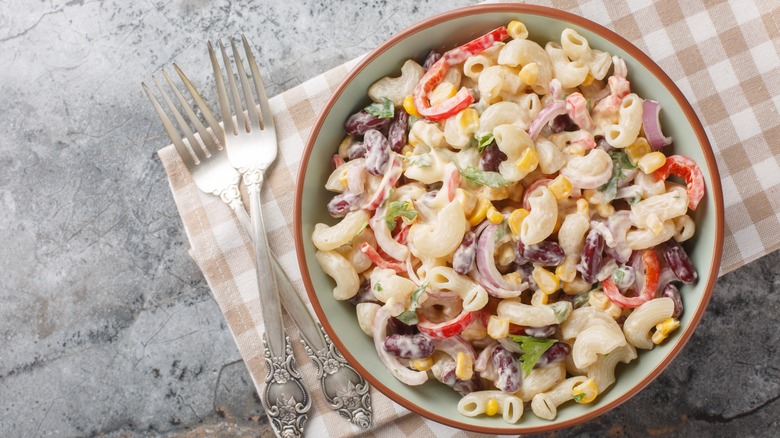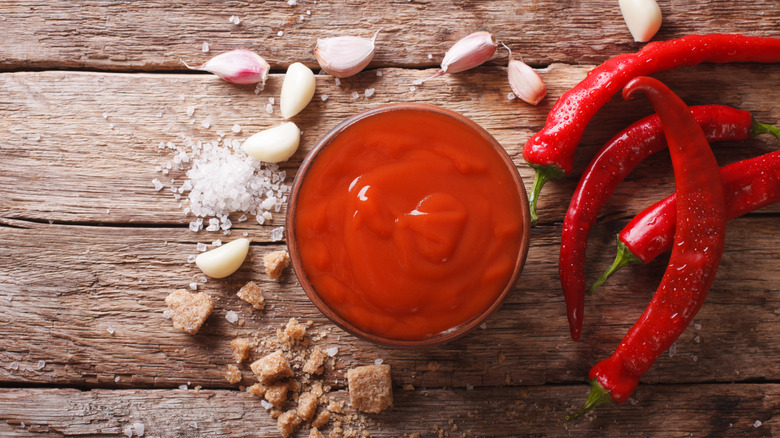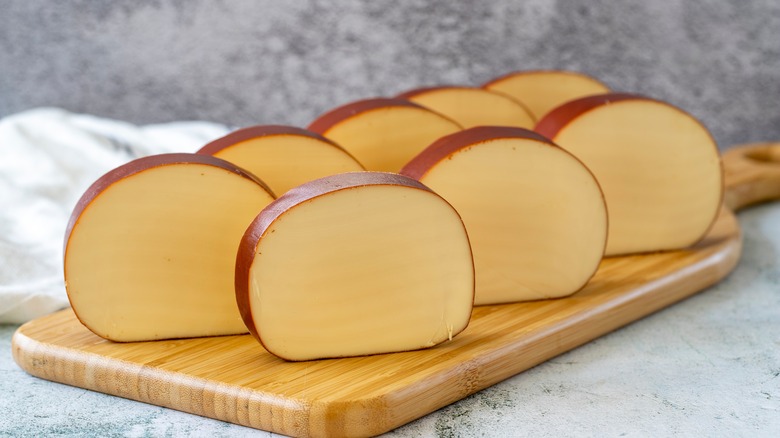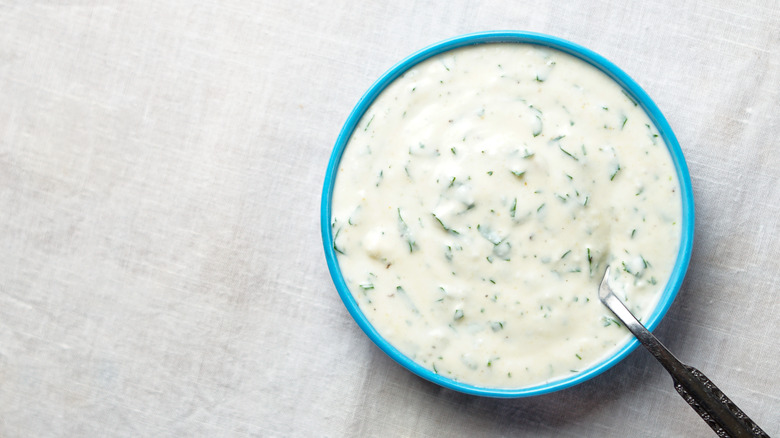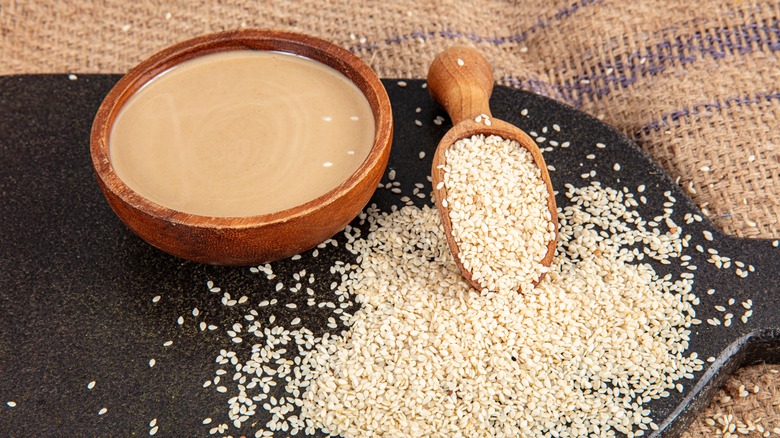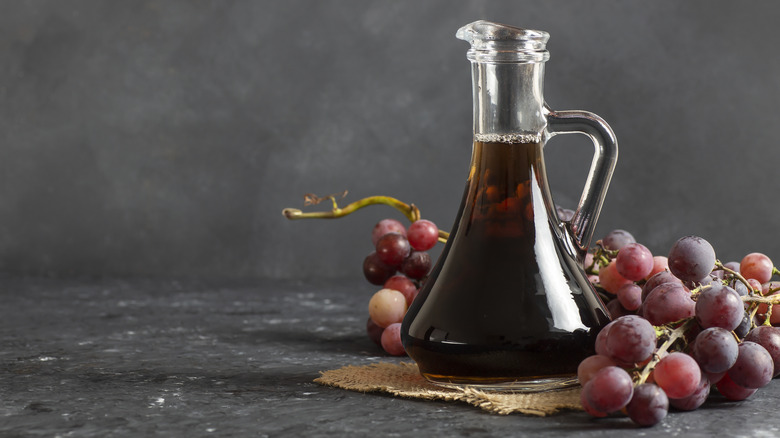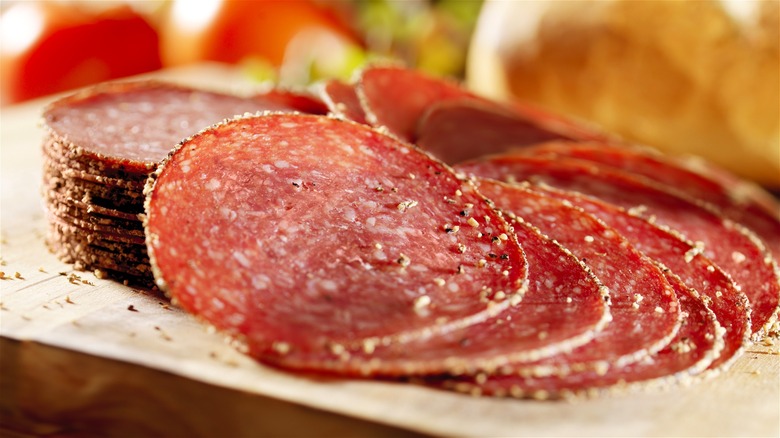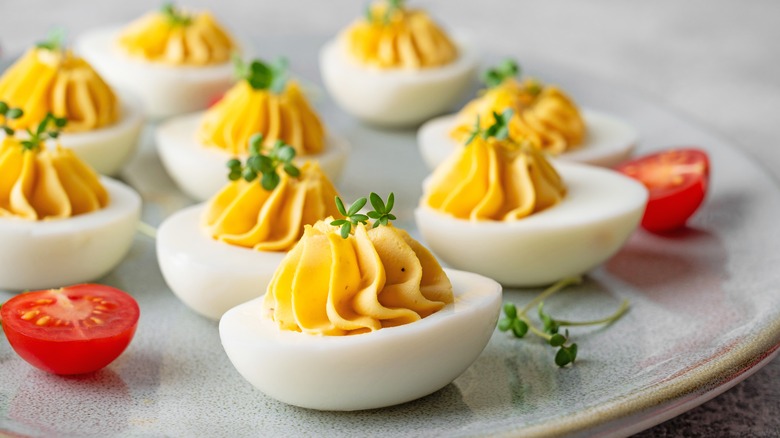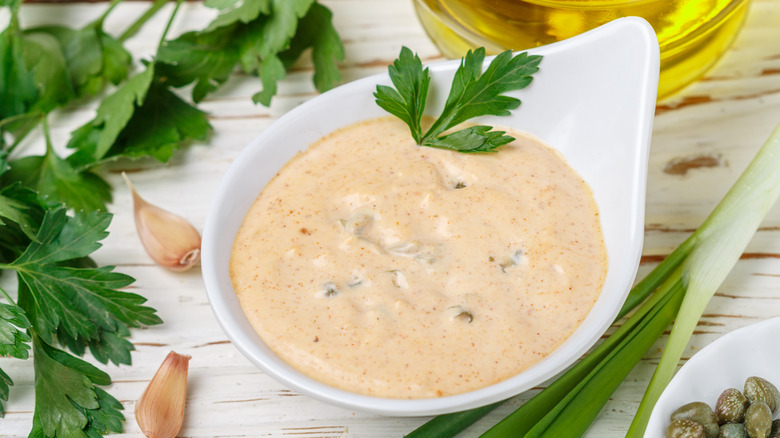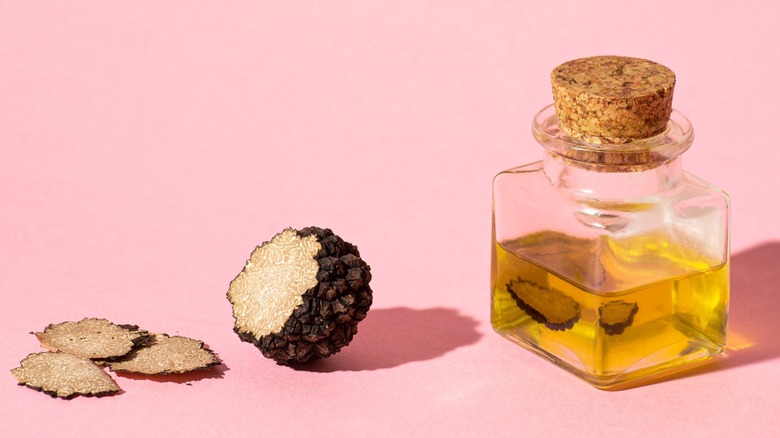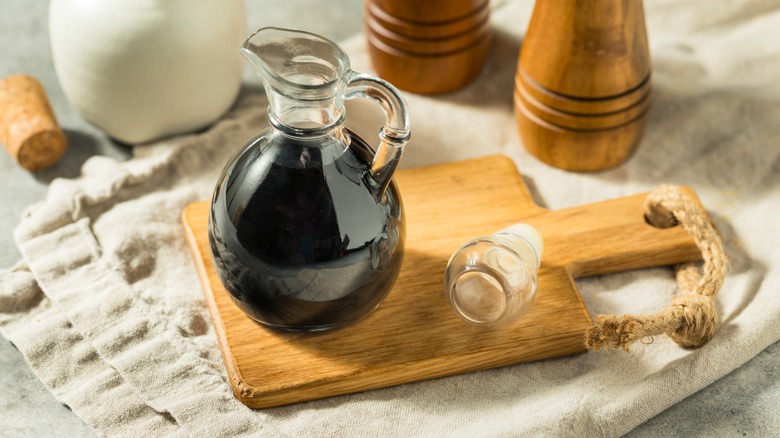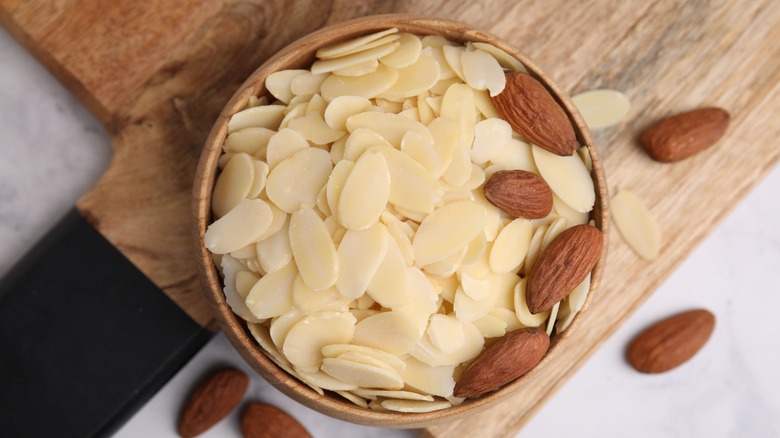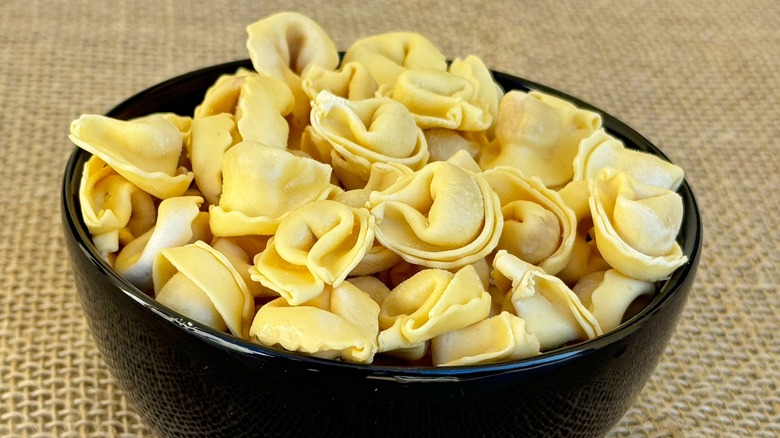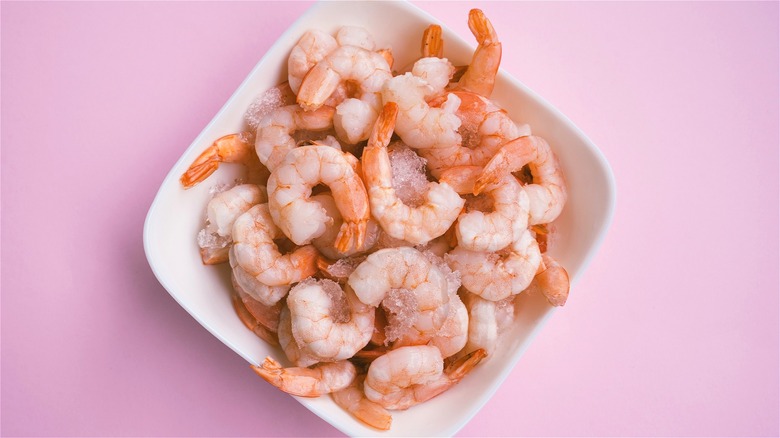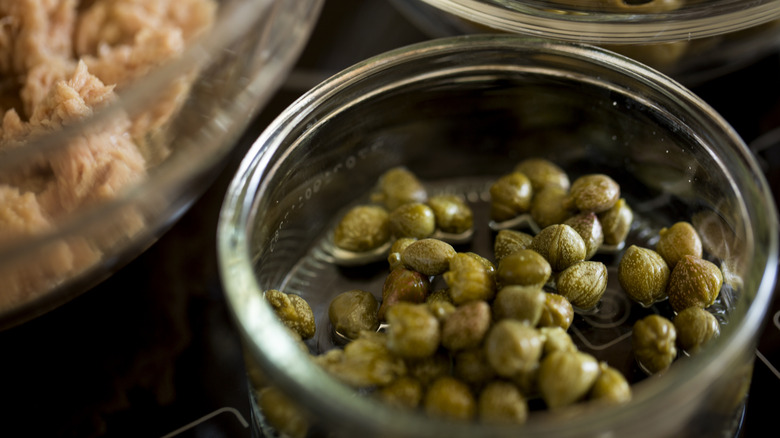14 Ingredients That Will Take Your Pasta Salad To The Next Level
Is there a bigger crowd-pleaser than a simple pasta salad? We don't think so. This evergreen combination of tender pasta, juicy vegetables, sprightly herbs, and a zingy dressing provides more than the sum of its parts. It manages to hit almost every taste in each mouthful — combining acidity, savoriness, sweetness, and saltiness — and its collection of textures makes each bite an event in itself. However, there are ways that you can improve upon this timeless dish that you probably haven't even thought of, by using some ingredients that will take your pasta salad in entirely new directions.
The beauty of pasta salad is that, while it's big on flavor, it's also exceptionally receptive to new tastes. Pasta salads absorb spice well without letting these flavors become too dominant. Plus, when ingredients such as sriracha or pepperoni are added, they can give pasta salad a little piquancy and brightness. Creamy ingredients like ranch or tahini can also improve the dish's texture while contributing more flavor than regular mayonnaise. Additionally, who said that you have to use plain old penne in your salad? You can even upgrade the pasta itself to give every forkful maximum flavor. Ready to cook? Let's go.
1. Sriracha
We're big advocates of adding sriracha to pretty much anything, but it really comes into its own in pasta salad. Sriracha adds immediate spice and heat to pasta salad, turning a dish that's normally savory and mellow into something sharp and layered. Luckily, sriracha ranks fairly low on the Scoville scale in the grand scheme of things, and, while it may be hotter than something like Frank's Red Hot, you can rest assured that it won't make your pasta salad inedible.
The intensity of your sriracha in pasta salad, however, depends on how much you add. If you want your pasta salad to have a little heat, but not too much kick, a tablespoon or two will do the trick. For more intensity, replace more of your mayonnaise with sriracha, or use an especially hot brand.
Remember, too, that sriracha won't just add heat: The sauce is made with lots of garlic, sugar, and vinegar, and so it'll also add sweetness, acidity, and a savory kick. It's worth remembering this when you add your other ingredients, so you can keep everything balanced.
2. Smoked Gouda
One flavor dimension that pasta salad often lacks is smokiness. We'll be the first to admit that you don't need it to make a good pasta salad, but adding it raises the bar, adding a gentle undertone of woodiness that helps stop the dish from becoming too tart. In our opinion, the best way to achieve this is by throwing in some cubed smoked Gouda. Each bite of Gouda gives your salad a gentle, creamy smokiness, pairing well with your dressing, while also contrasting with it thrillingly. It also bulks out your salad, and gives it an extra boost of protein.
If you don't have smoked Gouda on hand, you can use any type of smoked cheese you like. Smoked cheddar, provolone, and scamorza can also give your pasta salad extra flavor, with each cheese can add in its own element: Cheddar contributes sharpness, while scamorza has a creaminess to it. Throwing in smoked meats adds the same woodiness, and imbues your pasta salad with an additional pop of umami. If you're following a plant-based diet, try cubing up some charred red peppers or roasted zucchini, and adding that to your salad for that same smoky effect.
3. Ranch dressing
This condiment goes with literally everything, so it's no surprise that ranch is the creamy pasta salad upgrade you need. Using ranch takes things to the next level, by adding way more flavor than regular mayonnaise, and taking the hard work out of seasoning your dish. Because ranch is already flavored with herbs and lemon juice, it comes preloaded with bright, lively flavors. Its buttermilk content, meanwhile, adds an all-important sourness to your pasta salad, which helps liven up the neutral, gentle-tasting pasta.
The best thing is that you don't even need to make your own ranch. If you're feeling lazy and just want a flavor-packed salad in minutes, buy a bottled dressing and slather it onto your ingredients. Ranch dressing also remains a good base for other flavors, despite being loaded with ingredients already. It works well with spicy additions (like chili flakes or hot sauce) and can be made even more sour with a pop of lemon or lime juice. Alternatively, amp up its savory elements by pouring in some granulated garlic. Just try to be modest with what you add to the ranch, as while it's good at absorbing flavors, throwing in everything you can get your hands on will make things chaotic.
4. Tahini
Ask people what they dress their pasta salad with, and the vast majority of people will respond with either mayonnaise or oil. Now, there's nothing wrong with using either of these ingredients — but next time you whip this dish up, try opting for tahini instead. Tahini is made with ground sesame seeds, and has an intensely nutty flavor and a slight bitterness that pairs perfectly with acidity. Its peanut butter-like creaminess also allows it to coat every piece of pasta with a slick, flavorful covering, giving it the same textural effect as mayonnaise.
It's worth pointing out, though, that using tahini can be tricky. There are times when it can be a little too thick, and its nuttiness can be a bit overpowering. It's therefore best to balance it with a few other ingredients. Using lemon juice or vinegar will thin out the tahini slightly and boost its acidic notes. It's also worth cutting it with another liquid, like oil, mayo, or even Greek yogurt, so that it goes a little further and its flavor is spread out somewhat. Make sure you stir your tahini well before using it, too, as it tends to separate in its container.
5. Aged red wine vinegar
Everyone knows that to really pop, pasta salad needs acidity. Where you get it from, however, can significantly change the profile of your dish. Lemon juice, lime juice, and white wine vinegar can all give your dish a zingy, intense acidity, without too much distraction from other flavors, while balsamic vinegar can give the salad a fruity nuttiness.
However, all of these pale in comparison to aged red wine vinegar, the secret ingredient you need for pasta salad. Aged red wine vinegar is left to mature in oak barrels, which gives each spoonful a smoky, woody complexity. The aging process also takes the sting out of its acid notes, meaning that it supplies your dish with a gentle bitterness without overpowering things, and it also awakens a gentle fruitiness in the vinegar that's somewhat lost in the younger versions. Remember that you won't need much aged red wine vinegar in your salad: A tablespoon or two will do if you're making multiple portions. Remember, as well, to balance out your acidity with a touch of sweetness, by adding honey or sugar.
6. Pepperoni
If you're not adding pepperoni to your pasta salad, you're missing out. Pepperoni helps to give your pasta salad the meatiness that it seriously needs, and it also gives your salad a slight spice that deepens its flavor and stops it from getting too one-note. Pepperoni also provides pasta salad with a chewy texture and a boost of saltiness that helps to season it, which will get stronger the longer your pasta salad sits.
It's this saltiness, however, that can also be its downfall. Pepperoni can be incredibly high in sodium, and if you're mixing it with other sodium-rich ingredients and topping it all off with salt, your pasta salad will quickly become inedible. For this reason, we recommend adding your pepperoni before you add any extra salt, and allowing it to meld with your dressing and your other ingredients. Then, do a taste test. If you find that it's already too salty, you might need to rebalance your dressing by adding some more acid or oil. It may also be helpful to add less pepperoni than you might think at the beginning, so that you can boost the amount later, if it's not overpowering.
7. Deviled eggs
Adding eggs to pasta salad is an upgrade that lots of people will be familiar with — and while it's a reliable move, it can also be pretty boring. Throwing deviled eggs in, however, can give your pasta salad new life, boosting its protein content while keeping its consistency smooth. To add deviled eggs to your salad, you first have to make the deviled egg filling, by scooping out your egg yolks and blending them with mayonnaise, vinegar, mustard, and salt and pepper. Then, you can use this filling to dress your pasta and the other ingredients in your salad.
Doing this infuses your pasta salad with a deviled egg flavor, in all its sharp yet creamy goodness. Because deviled eggs are so versatile, you can pull this flavor in other directions: Add a few pinches of cayenne pepper to give it a kick, some snipped chives for a little brightness, or mix in some finely-chopped capers for a briny, lip-puckering bite. As for the egg whites, you can either chop them up and pop them in your salad for extra texture, or leave them out and allow your salad to be ultra-creamy.
8. Remoulade
Forget your mayonnaise, your vinaigrette, or your olive oil — if you want to give your pasta salad dressing a serious boost, remoulade is the creamy sauce you need. This French sauce is a flavor explosion: Similar to tartar sauce, it gets an extra kick from ingredients like chopped pickles, horseradish, or anchovies, depending on your brand or what you mix into it. It can also be layered with spice, thanks to additions like cayenne pepper, paprika, or Cajun seasoning.
Remoulade's mayonnaise base, meanwhile, mellows out all of the sharper, more direct flavors, allowing them to pop through, instead of dominating your dish. Although this sauce is typically served with seafood, you don't have to include any in your pasta salad for it to work. It's just as effective with chopped vegetables as it is with protein. We recommend using pasta with a slightly more interesting texture if you want to add remoulade, as otherwise, things can get a little too gloopy and lacking in bite. Fusilli or farfalle (also known as bow tie pasta) are great choices here, as they hold the sauce well without being overpowered by it. Al dente penne can also be a great option, as the remoulade will work its way into the pasta's ridges.
9. Truffle oil
Things are about to get very fancy, folks. With a dash of truffle oil, you can turn your pasta salad into a deeply fragranced, complex wonder. Truffle oil imbues any dish with woody, garlicky, gently peppery notes, but it can often be lost in the mix with other ingredients. However, in pasta salad, it can take center stage, thanks to the relatively neutral flavor of the pasta and the milder notes of other ingredients.
Using truffle oil properly takes a bit of skill, though. This oil can be incredibly overpowering if you add too much of it, so ensure that you're only pouring it in drop by drop, mixing it in thoroughly before tasting the salad. Plus, you're going to want to make sure that the other ingredients you use complement the truffle oil, not work against it. This oil is best used in pasta salads centered around Mediterranean flavors that champion fresh additions, like zesty pasta salads crammed with fresh tomatoes, basil, and lemon juice in a light, oil-based dressing. Above all, try to use the best-quality truffle oil you can find — the cheap stuff can taste really soapy, and is more likely to ruin your pasta salad than improve it.
10. Soy glaze
We've all had bland pasta salads in our time, but turning one around can be trickier than you think. If your pasta salad is under-seasoned, adding salt and pepper can help, but you run the risk of overpowering it with sodium and unnecessary spices. Instead, you should look to add one secret ingredient to bland pasta salad: a drizzle of sweet soy glaze. Soy glazes unleash an astonishing amount of flavor into pasta salads, filling them with umami, sweetness, and a pop of acidity (as well as the all-important saltiness). They also do so without thinning out your pasta salad too much, and are especially good at taking on spicy flavors.
Making a soy glaze at home is pretty simple. In its simplest form, you just have to mix soy sauce, brown sugar, an acid like lime juice, ginger, and garlic together, and you're good to go. However, when adding it to pasta salad, you're going to want to cook it to intensify its flavor and thicken it up. Pour your ingredients into a pot, and simmer the glaze gently for about half an hour until it's thick, syrupy, and bursting with flavor. Drizzle it to your pasta salad, and enjoy.
11. Flaked almonds
One thing that pasta salad is often seriously lacking is crispness. While fresh veggies can often provide some useful crunch, there's a subtle difference between crunch and crispness: The latter gives you a delicate, dry, brittle texture that makes everything taste so much better. How do you add crispness, though, without things getting soggy and mushy? You use flaked almonds. Flaked almonds retain their crispness even when they're drenched in your pasta salad dressing, and they're small enough to distribute evenly throughout your salad without distracting from the other ingredients.
Flaked almonds also give your pasta salad a slightly nutty and gently sweet flavor. Plus, they work well with whatever dressing you choose, whether you're going for a classic mayonnaise-based pasta salad, or a Mediterranean pasta salad dressed with olive oil and vinegar and boosted with dried herbs. If you can't find any flaked almonds, you can also use chopped or even whole ones — although bear in mind that whole almonds can be a little tough and distracting when contrasted with the soft, bouncy pasta. You can also use any other chopped nuts you can get your hands on, as they'll all give your pasta salad that all-important crispness.
12. Tortellini
You can add every ingredient you can get your hands on to your pasta salad, but here's the thing: If you're not upgrading the pasta itself, you're missing out. That's why you need to use tortellini for your next pasta salad. Tortellini adds flavor from the inside out, giving each bite added taste through the pasta's filling, and it also gives your pasta salad a pleasing chunkiness that makes it feel more substantial.
To make the most of using tortellini in pasta salad, it's best not to go overboard with the fillings. While strong-flavored tortellini fillings may work well if you're simply eating it with a little cheese for dinner, when you pair spicy tortellini with fresh veggies and a sprightly dressing, it kinda doesn't work. Rather than ruin your pasta salad, opt for a simple cheese or spinach tortellini, both of which will pair well with your other flavors. It's also best not to bog down tortellini in mayo-based dressings: Because the inside of the pasta is already quite creamy, adding another creamy element can make things unpleasantly dense. Instead, go for a zingy vinaigrette dressing.
13. Shrimp
Pasta salad doesn't have to be a light side. With the addition of proteins, you can make it way more filling and even turn it into a main dish. One of the best ingredients to liven up a boring pasta salad is shrimp. Shrimp has the perfect balance of tenderness to firmness for this dish: It's soft enough not to contrast too heavily against the pasta, while its substantial bite means that it stands out on its own.
Shrimp also has a gentle, slightly sweet flavor that works brilliantly with mayonnaise-based dressings, and which doesn't get in the way of your other ingredients. Because it comes in loads of different sizes, too, you can match your shrimp to the pasta you're using. Jumbo shrimp goes well with chunky pieces of rigatoni, whereas small shrimp are a better choice for macaroni or orzo. Shrimp's flavor also makes it the perfect addition to spicier pasta salads, where the spice offsets the sweetness of the seafood. Try spiking your shrimp pasta salad with a sprinkle of Old Bay seasoning, giving it a deep fragrance and a peppery intensity.
14. Caper brine
It's common knowledge that pasta salads need some acidity to really make them pop, but sometimes, lemon juice or white vinegar just don't cut the mustard. If you want to boost the dish's acidity while also giving it a floral note, caper brine is the way to go. Like other brines, caper brine gives any pasta salad a hit of vinegar, while also seasoning it with its saltiness and sugar. The brine also takes on the flavor of the capers as it sits with them, giving it a slight savoriness and a fresh, zesty taste.
So, why use caper brine instead of capers in a pasta salad? One word: Texture. When you add capers into your pasta salad, you change its texture, adding squishy pops and bites throughout. This can be pleasant, but if your pasta salad already has a lot going on texturally, it can introduce one too many things into the fray. By using the brine, however, you get all of the flavor and none of the distraction.
